Writing
Wednesday, September 8th, 2021
Rewilding The Page – The Urban Forest Writing Map
Lush urban nature populates our towns and cities. Flourishing gardens, parks, city forests and woods, pockets of majestic trees, shrubs and foliage all create a green belt around us.
Spending time outside is good for our mind, body and spirit. These 12 creative writing prompts in the Rewilding The Page Writing Map invite you to continue deepening your connection with the green spaces on your doorstep.
Through writing, walking, drawing or meditation these writing activities help you connect with the colours, seasons, trees and plants in and around the spaces you inhabit.
Creative writing prompts by Jackee Holder and Shaun Levin
Illustrated by Gul E Raana
To purchase your copy for £7.99 + p&p send an email to info@jackeeholder.com
No Comments
Wednesday, May 12th, 2021
The Inner & Outer Nature Self Discovery Card Deck

The Inner & Outer Nature Self Discovery card deck launched in 2021 are a series of 49 nature and tree inspired journal and writing prompts.
Drawing on the metaphors and lessons abundant in nature, plants and trees the questions bring an organic invitation to your musings and inner reflections.
The writing prompts are a gentle way of reconnecting with nature both on the outside and the inside. Each question in the card deck draws from the rich metaphors and rhythms of nature.
By reconnecting with nature the questions are also an invitation to deepen your connection with your own inner nature.
To order send email to info@jackeeholder.com
Order your card deck for £21.99 plus p+p here
Pay via PayPal (no account necessary)
No Comments
Thursday, August 16th, 2018
A host of movers and shakers received accolades for their contributions to the coaching profession, at this year’s
Coaching at Work Awards.
The award results were announced by editor Liz Hall at a ceremony at the end of the annual Coaching at Work conference in London last month. This was followed by a reception sponsored by the online training provider the
Wisdom Tree Academy to celebrate the awards.
Craig G. Howe from the Wisdom Tree Academy handed out the plaques and certificates to the winners.
Jackee Holder received a Highly Commended Award for External Coaching/Mentoring Champion
Some of the Judges’ comments included:
“She’s a breath of fresh air, refreshingly willing to stand up and speak out, about diversity among other issues, challenging and inviting us as individuals and as a profession to stop burying our heads in the sand when it comes to diversity and inclusion.”
“A commitment to diversity and inclusion is core to Jackee’s coaching identity and practice and it greatly influences and impacts the diversity of perspective and understanding she brings to her work. One of the first black female coaches, she’s passionate about supporting organisations and the coaching profession to embrace diversity and inclusion, and has been championing the work of diversity and inclusion within the coaching profession for many years”
“She’s been willing to speak up about diversity during times when it’s been marginalised and ignored by much of the profession.”
“Her grounded enthusiasm and presence, cheerful warmth and her genuine interest in those she is in conversation with are immediately apparent. Strong foundation of professional practice from youth and community work with young offenders and young people leaving care, in management and in leadership of a mentoring project matching local young black students with BBC newsreaders, producers and directors.”
“Willing to take creative risks in coaching and training and from personal experience I know that she creates professional development spaces that say back to people that they matter as individuals, and that their history matters, as do the different strands of their diversity.”
Coaching at Work is an independently owned magazine, which publishes bi-monthly in a printed and digital format, in addition to monthly newsletters. It has been going since 2005. It also organises events such as an annual conference and masterclasses. Its global LinkedIn group has more than 50,000 members.
No Comments
Saturday, December 2nd, 2017
BBC Radio Scotlan d: Personal Best with life coach and author Jackee Holder explaining why we get caught up in habit and obligation at this time of year and how we can recapture the essence of what giving and receiving should be about.
d: Personal Best with life coach and author Jackee Holder explaining why we get caught up in habit and obligation at this time of year and how we can recapture the essence of what giving and receiving should be about.
Card-lover Jackee explains how she switched from being someone who dashed Christmas cards off at the last minute to someone who loves the whole experience of writing and sending them … and why it’s important not to lose sight of the fact that we’re primarily sending them to connect with others.
Listen here
No Comments
Monday, October 30th, 2017
In the quiet of the cloister voices echo
Like memories
Footsteps through the passage of time
In the garth an old lady carries her bags
Like soul-worries
Easing through the labyrinthine wind
I first came across the idea of writing a labyrinth through Jackee Holder’s “Paper Therapy” course. The exercise involves writing a problem on a labyrinth grid, starting from the outside and working to the centre, in as much detail as you can, pausing at the centre to receive what insight emerges and capturing that as you write your way back out. I didn’t do the exercise. I had no burning issues at the time, but to be honest it simply didn’t resonate with me.
I didn’t like the idea and couldn’t imagine using it. I ditched it and went on with the rest of the course.
Walking through the City a few weeks later, I thought the Cathedral cloister would be a quiet, calm and above all cool place to sit and scribble for a while. Sitting in the shadows, I was taken by a woman who seemed to be wandering aimlessly in the middle of the quad, clutching her shopping bags. She seemed sad, but soon I realised I was watching a meditation.
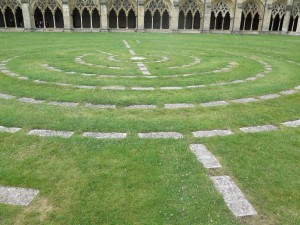 Given the work-generated negativity that I was disgorging into my book, I thought: well, why not? After she had left, I dropped my own bag on the grass and stepped into the labyrinth.
Given the work-generated negativity that I was disgorging into my book, I thought: well, why not? After she had left, I dropped my own bag on the grass and stepped into the labyrinth.
Ignoring the writing exercise instructions I didn’t dwell or dig into details. I hardly even put words around my struggle with ‘letting go’ in order to move forward. I simply held the idea lightly in my mind as I walked to centre. In the middle, I didn’t stop to think, but simply circled the centre stone and asked for – not an answer, not a certainty, just a bit of guidance, a little support, a prompt. And I walked slowly out along the pathways with an open mind.
The answer, when it came, did come in words: You are trying to push the river. Let it go and it will still flow. Stop trying to force timescales, that will be counter-productive. Allow everything to unfold in its own time. Be gentle – not just with yourself, but with everyone else. Being bold does not require you to be harsh. Standing back, is not the same as turning your back. For all time is short, a heady rush is not the way. Let it slow. Let it flow.
Did I “hear” them? Did I think them? Whether they came from within or without doesn’t much matter.
I was so intrigued by the experience, that I went back a week or so later: this time to walk it barefoot. I’d love to give some in depth esoteric reason for that – but basically, I spend a lot of my time barefoot, probably because I was brought up not to – so it just felt like the thing to do. This time it wasn’t about seeking guidance, but about trying to understand how the meditation works.
Firstly, it is a slow walk. I think of mediaeval monks processing round the cloister – I almost want to hear a Gregorian chant – and try to set my pace to what I imagine that might have been. Then I simply focus on the path.
Labyrinths are made in different ways. The Norwich Cathedral one is marked out by stones, but the path itself is in the green. It’s almost designed to encourage that bare sole (!) connection to the earth.
This is what I discovered…
The path turns and seems to draw you away from the centre before turning again. Trust in the design, go with the flow, you will be inexorably guided to the centre: the anchor point.
There, there is nothing but yourself. A stone tablet in the grass to be circled, to hold you to your own centre while you gather understanding.
And then you walk the path again, only it’s not the same path, for all it still bears your footprints. This is not a retreat to your starting point, but an adventuring forth from your anchor, the rock that will always be there now that you’ve found it. The path twists and turns taking you close back to your centre, reassuring, but gently leading you equally inexorably out into the world, until the gateway is reached, the guided path falls away and the vast potential of unguarded openness is available to you.
The sense of peace obtained from this second walk is hard to describe. I think I set out to understand how the first one had “worked” – maybe I was putting it to the test in a way. Was it just some kind of fluke? What I found was that of course it was. It was the fluke of realising that I know who I am and what my purpose is, but I need a ritual to quieten me down to listen to myself. The fluke of finally internalising the belief that if I want guidance from the universe I have to shut up long enough to hear her quiet whispers.
I have learnt that I although I am now certain of my centre, I won’t always be moving towards my purpose. Sometimes the path will seem to move in the opposite direction. I have learnt that sometimes I will need to draw back to the security of my anchor. They say ships are safe in harbour, but that’s not what ships are built for. I heartily endorse that – but ships do still need safe harbours. I’m beginning to think I might always find mine by walking slowly, and possibly barefoot, through a symbolic artificial pathway, sacred only because we choose to make it so.
Click here to find out more about Lesley Mason
No Comments
Monday, January 2nd, 2017
There is a Weeping Willow tree across the road from where I live that grows with wild abandon. It is nestled in front of an old electricity hut and positioned in-between two rows of terraced houses tightly knitted together almost in an urban attempt to give this tree the space it needs.
Perhaps it’s the solitary nature of the tree that seems to not be directly connected to the land of any of the houses on either side that gives it it’s right to spread out into the surrounding air space spilling over abundantly onto the pavement and walkway.
Walking past the tree requires either stepping into the road and strongly increasing your chances of being hit by one of the many cars that race daily up and down this road or delicately pushing your way through the dangling rope like catkins of the willow branches hanging like curtains that need to be pushed apart so you can take your next step. It won’t be long before the tree’s hanging branches will hit the road and the bodies of the cars obscuring windscreens before I suspect something will be done about cutting it back, I hope not too drastically.
I first met the tree in springtime of this year. At the time the tree was resplendent in its blossoming of flowing wavy branches and long dangling catkins. In the summer it played magic with the sunlight sometimes becoming almost invisible until one of her swinging branches hit you in the face as you walked past.
The Weeping Willow Tree in the Springtime
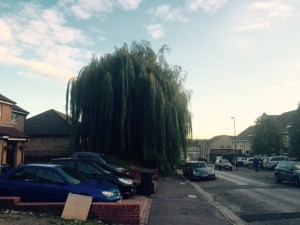
Then last week as I headed out for my early morning walk around the neighbourhood I looked up the street in the trees direction and realised almost overnight she had gone almost bald. The lime blushed green of the trees long dangling catkins had been thinned out and threadbare, washed out from the lack of green chlorophyll that makes leaves green.
The same Weeping Willow Tree Christmas 2016.
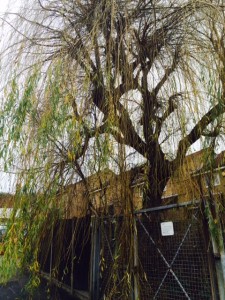
The trees appearance took me by surprise. I am sure the week before the tree was fully clothed. It appeared as if the disrobing had happened overnight as can the events in our own lives that sometimes derail and leave you feeling bare like the Willow looked.
It was a reminder that each of the seasons carries its own medicine. That the winter of the Willow tree even though it may appear at first glance to have deprived the tree of its full glory was also a time of rest and renewal a chance for the tree to take out to prepare for new growth that will arrive in the springtime.
This is true for life events and personal experiences that leave us devastated. We forget that this season of our lives can also be an opportunity to start over again, to in time when we have healed to plant new seeds and of the importance of making time to rest and renew our energies especially when going through difficult or turbulent times. It can be easy to forget that nature knows the science of the seasons much better than we do and that the cycle of the seasons is a mirror for the cycle of our own lives and the things we experience. In time if we trust enough and when we do the inner work rather than conceptualise what needs to be done we will grow new hopes and possibilities as we head towards the season of spring in our own cycle of renewal.
I do not write these words from a distance. I am as close to the Willow tree geographically as I am emotionally and psychologically. I too am rendered bare in many areas of my life right now as I rebuild the process of starting over. The space feels tender and vulnerable sure signs that there is a need to rest so cells can be renewed and spirits and energies replenished. “Our cells sometimes need to fall like leaves from the trees before they can regenerate and be renewed,” writes Madison Taylor in one of her weekly blog posts on the Daily Om website.
As I watch the Willow tree I am reminded of its resilience, of how in its stillness it will gather strength and take the lessons from this quiet period of its life into the next cycle confident that what will come will be a new period of fertility and growth.
I take comfort and courage from the Willow’s nakedness as I tenderly nurse my own dreams back into a new lease of life. To the naked eye the tree may appear dormant when in fact everything underground is moving even though it is not yet visible from the outside. New leaves are preparing to sprout and bud. By time the spring arrives the tree will burst into bloom in a space of time that seems sudden but which in fact took time.
Change can be like that. Often the change takes place within invisible externally before you see and experience the full effect of the change process on the outside.
Trees are both teachers to us about the delicacy and fragility of life and all that it brings. A tree becomes a tree from the possibility of one seed from a thousand taking root. Knowing this makes me think that each tree is literally a miracle and could we not say the same for us humans?
My reverence for the nature and spirit of trees has resulted in a newly published Writing With Fabulous Trees Writing Map created in collaboration with the genius Shaun Levin of Writing Maps http://www.jackeeholder.com/tree/writing-with-fabulous-trees-writing-map-for-parks-gardens-and-green-spaces/
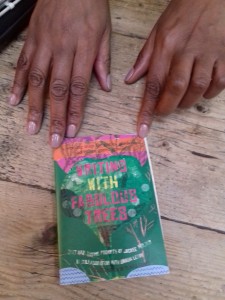 It’s an illustrated collection of 12 Tree inspired writing prompts that explores the wisdom and lessons we can learn from trees as well as how tree wisdoms can provide insight and reflection on our own lives. In a handy pocket sized map that folds out the prompts also encourages a more intimate connection with the trees in your local neighbourhood, parks and green spaces through engagement with the writing prompts.
It’s an illustrated collection of 12 Tree inspired writing prompts that explores the wisdom and lessons we can learn from trees as well as how tree wisdoms can provide insight and reflection on our own lives. In a handy pocket sized map that folds out the prompts also encourages a more intimate connection with the trees in your local neighbourhood, parks and green spaces through engagement with the writing prompts.
Get writing with the trees and see what trees teach you about life and living.
Click here to order a copy of the new Writing With Fabulous Trees Writing Map
http://www.writingmaps.com/collections/all-the-maps/products/tree-map
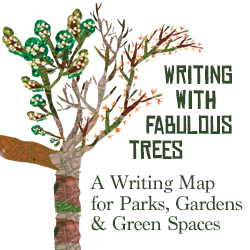
No Comments
Thursday, December 15th, 2016
We rely on trees for the paper we write on and for the oxygen in the air we breathe. We need trees probably more than we sometimes care to admit. Deepening your connections with trees can be calming and oddly reassuring. 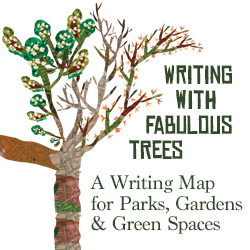 Trees have long inspired many poems, novels and short stories of writers in many ways. These creative writing prompts are devised to create a longer conversation about trees from your past and to stimulate you to indulge in a more reflective inquiry into how engaging and writing about trees can help you develop greater intimacy with yourself and your characters in sometimes surprising and unexpected ways. This writing map tucked into a pocket or a rucksack is the perfect companion on long walks in nature or whilst you are strolling through the city. You might be inspired to take a photo of a tree on your travels, slow down and experiment with drawing a tree to writing stories or personal narratives stimulated by the roots of your own family tree? The prompts and quotes generate learning and insight about yourself and where you come from as well as the opportunity to learn more about the host of benefits trees have to offer. Writing With Fabulous Trees will encourage you to be more observant about the trees in your neighbouring or surrounding parks and green spaces and even the trees in your street or in your own private garden will take on new and different meaning. Order Now £7.99 plus p&p
Trees have long inspired many poems, novels and short stories of writers in many ways. These creative writing prompts are devised to create a longer conversation about trees from your past and to stimulate you to indulge in a more reflective inquiry into how engaging and writing about trees can help you develop greater intimacy with yourself and your characters in sometimes surprising and unexpected ways. This writing map tucked into a pocket or a rucksack is the perfect companion on long walks in nature or whilst you are strolling through the city. You might be inspired to take a photo of a tree on your travels, slow down and experiment with drawing a tree to writing stories or personal narratives stimulated by the roots of your own family tree? The prompts and quotes generate learning and insight about yourself and where you come from as well as the opportunity to learn more about the host of benefits trees have to offer. Writing With Fabulous Trees will encourage you to be more observant about the trees in your neighbouring or surrounding parks and green spaces and even the trees in your street or in your own private garden will take on new and different meaning. Order Now £7.99 plus p&p
Text and writing prompts by Jackee Holder in collaboration with Shaun Levin and with illustrations by Flazia Felipe. The A3 map (297x420mm) folds into A6 (105x148mm, postcard size), and is printed in England. NOTE: Some content may not be appropriate for writers under 16
No Comments
Saturday, August 20th, 2016
“City life cuts you off from the seasons, but walking restores your awareness.“ – Joan Bakewell
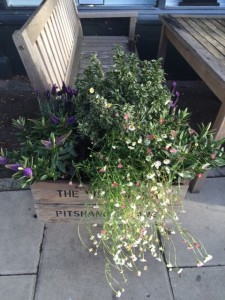
This weekend I am staying in Ealing on a city writing retreat hosted by the wonderful Clare Berry www.clarebarry.com It’s a perfect opportunity to unwind and spend chunks of time writing away from the distractions of life back at home.
I have fond memories of Ealing from childhood. In the sixties my Dad would drive my Mum, baby brother and me from South London in his bottle green Morris Minor car to the home of my godmother Aunty Eunice in Ealing.
At the time through my child’s eye their home was huge and even the pavements on the road they lived on were double the size of the slither of a road we lived on in Camberwell in London which may well have been one of the smallest streets in the whole of city. And to top off my idyllic memories the sun was always shining when we visited.
Now I am a half a century and more older the streets seem smaller in the Ealing suburb as do the houses but the energy of the place feels the same.
Sitting in the front reception room it is a while before I notice how quiet the area is compared to where I’ve lived for the last ten years. The moment reminds me that when we make time to get still the nature and vibration of a place speaks to us in many ways.
One way I get to know and really connect with the spirit of a place is by walking. Today as I head over the hill from the home I am staying in I am greeted with a wonderful view of the river Brent in the far distance. The river is a slim shimmering slit of silver from the naked eye but somehow its presence calms me knowing that water is nearby.
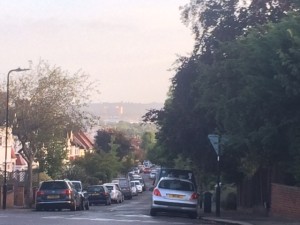
My host has drawn me a map. The wildness of a map hand drawn on paper rather than relying on Google maps heightens my sense of adventure. The night before I ask my host to point me in the direction of the nearby parks. Green spaces, what I call the lungs of a place always give me the heartbeat of the place and act as a natural compass to explore the area.
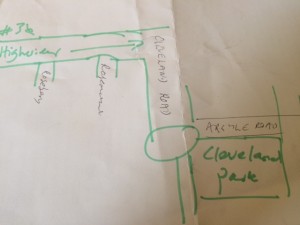
The roads I wander down are abundantly tree lined with assortments of red and orange geraniums in almost every other house or window box.
I walk for over ninety minutes and find myself winding down roads adorned with lovely cottages and front gardens showcasing huge plants like the cactus in the photograph below.
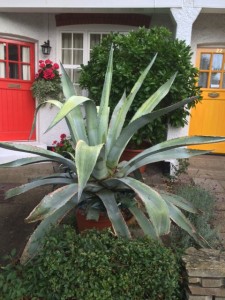
Walking accentuates the power of observation. It’s an ideal activity to sharpen and improve your writing skills because it allows you to really see in a way we don’t see and experience when travelling by car or transport.
Walking also contributes to the quality of your thinking. Both running and walking are incubators for the emergence of some of the best ever ideas and solutions for issues and dilemmas across my personal and professional life. What’s great is that it requires very little effort on my part.
The minutes flow by and I am lost on my meanderings. A good, long walk is always a great way for me to preparing to write. Well into my walk I catch sight of a notice board at the bottom of one of the long front gardens I am passing by. The kind you get in front of village churches.
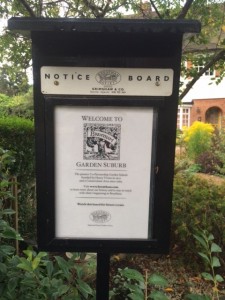
On reading I discover that I am in the heart of the Brentham conservation area. This is the reason why the gardens and plant life along these streets are so rich and vivid.

Here’s what it says on the website about the Brentham garden suburb:
Like a country village in the city, Brentham Garden Suburb is a little-known architectural gem in the midst of west London. The charming and distinctive estate of more than 600 homes and green spaces in north Ealing dates back to the early twentieth-century, when the Garden City movement was growing – as a reaction against the overcrowding and squalor of many homes in the city.
Brentham’s influence on domestic architecture and town planning is out of all proportion to its size. As you walk around, you find the tree-lined streets are curved and the houses arranged in irregular groups, creating a surprising view around every corner.Brentham also made history in another way. It was the first Garden Suburb built on ‘Co-partnership’ principles, so that residents could buy shares in their homes. www.brentham.com
My new discovery explains the reason behind the lawned alleyways I notice in-between many of the houses. My host informs me later that part of the original setting up of the co-operative included allocation of communal allotments and each house being gifted an apple tree.
I unexpectedly and almost immediately learn a lot about the area from a woman walking her dog who spots me taking a photo of the notice board and comes over to talk to me.
My walk without a mobile device except to take photos is energising. By the time I have arrived back at my host’s home I am lighter but also brimming over with words and I cannot wait to sit down and write this post.
I am curious. How well do you know the neighbourhood you live in by foot? I am about to leave the leafy area of East Dulwich in London where I have lived for ten years. The area I am moving to does not compare in many levels. However over the last few weeks I have been going for early morning walks around the neighbourhood I am moving to and discovering some surprise hidden gems about the area that is to become my new home. Walking each day is deepening an intimacy with my new neighbourhood and highlighting often in unexpected ways its hidden strengths and interesting nooks and crannies.
Research continues to add to the growing list of physical and psychological benefits gained from walking including adding seven years to your life, improving the quality of your sleep, acting as a natural anti-depressant and more recent research findings are highlighting the connections between how walking in nature contributes to lower levels of depression.
The self-reflective questions below can help connect you with the many benefits and gains of walking that could be yours.
- How might you make more time to explore on foot the area you live or work in?
- Get creative and curate a photo essay on your phone of the scenes that capture your interest from occasional walks. As the saying goes a picture paints a thousand words.
- To fully embody your walk connect with how you are feeling in your body as you walk? What are the physical signs telling you about your personal health and well-being?
- Carry out a before and after check in when walking to compare how you feel mentally and physically. Does your mind feel as busy? Or are you left feeling more spacious and clear.
Contemplate realistically where in your schedule can you plan in more time to walk without an agenda?
Hold in mind the question whatever your profession: What are the benefits and the gains from walking becoming more of a regular activity in your life?
No Comments
Wednesday, May 11th, 2016

I love it when a piece of writing catches my attention.
I am a fan and appreciative of long writing. I do not uphold this whole idea of bite size. Bite size has it’s place in the fast corridors of modern living but I prefer savouring and reading writing I am interested and passionate about. I am excited by sinking into a moving blog post, listening from start to finish to a podcast that is engaging and interesting. In amongst the onslaught of daily emails I do sit and regularly read and contemplate essays, writings and podcasts of all kinds. I am a curator of hundreds of quotes meticulously recorded on coloured index cards gathered from those moments of long listening or reading.
So when I came across Joan’s personal essay ‘Trees I Have Loved’ (thanks to originally listening to a great podcast interview with Joan Leof and Nathan Ohren over at Journal Talk) which led me to her marvellous book Matryoshka: Uncovering Your Many Selves Through Writing.
I knew I was in the presence of another kindred spirit. I have a Matryoshka doll which I often share with people on workshops and talks when demonstrating how important it is to uncover our masks and connect to the source of our true selves. So I was intrigued by the title of the book and the symbology and metaphor of the Matryoshka doll.
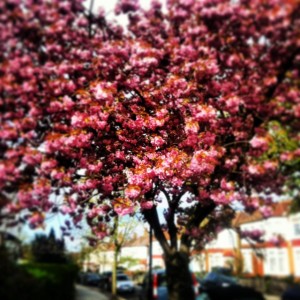
I ended up connecting with Joan online and shared with Joan the tree book I have been carrying around for a good few years that I have literally more or less written in my head but have not fully yet committed to the page. Joan’s essay on trees prompted me to get this project birthed. Joan has generously agreed for me to share her tree essay on the blog. You can read the essay Trees I Have Loved by following this link
Then, if this wets your appetite for more then head on over to her website to purchase a downloadable pdf copy of the book or Amazon where you can savour the collection of her personal essays on life.
Reading Matryoshka was one of those perfect reading moments when you are riveted to the spot and each essay you read strikes a chord for different reasons.
The essays are life affirming, challenging, stretching and inspiring and all very real and true to life. I noticed my whole body paying full attention as I read, nodding and shaking as I noted all the places where Joan’s stories deeply connected in some way with my own and still fully engaged when the experiences were different. I felt awakened as I journeyed with Joan through each of the essays. Each essay had me running to the page to write and capture my own story in words.
The reflective questions at the end of each chapter are thought provoking and stimulating and just working with one felt like it opened so much up. Joan’s writing felt hearty and whole, enveloped in having walked through both the dark and the light and coming out illuminated at the other end. Each essay felt like a flow of writing that had been mined from the heart and the soul.
See what you think. In the meantime enjoy Joan’s words and if you want more head to the links above and purchase a copy of Matryoshka (which has a beautiful front cover of a Russian Matryoshka doll) and enjoy the depth and wisdom of her essays as much as I did.
No Comments
Monday, February 15th, 2016

On my early morning walk today I came across a few visual sights I just had to capture on my iphone. In the first one I was struck by the vibrant sunshine orange of the vintage car and couldn’t stop thinking about who owned such a succulent car.
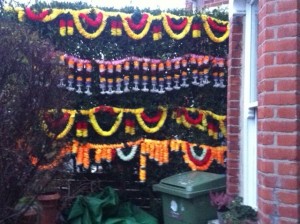
I was so busy taking the photo that it was only when I walked back up the same street that I discovered that perhaps the owner of the car or someone who they lived with had also adorned the hedge of their home. I was very intrigued by what the adornment was for. In my mind it looked like some kind of Hindu celebration. Again the visual imagery got my creative juices flowing. Who, why, what did it all mean?

Then as I was heading toward the final ten minutes of my walk I looked down to find this beautiful, huggy teddy bear someone had left outside their home, I’m assuming for someone to take and give it a good home. It was gorgeous and in very good condition. I wondered about the child who it no longer had a home with. Or was I wrong to assume it was a child and maybe had a home with an adult? Again, if I were a fiction writer and maybe I am, I would have been writing about the family who orphaned the giant teddy bear and why. Also penning a short story about the new home it would soon, I was sure, be welcomed into.
Sometimes a photo essay becomes your journal entry like mine did today. My captured photos told the stories of the start to my day. How about capturing photo’s of your day and see what intrigues you?
No Comments

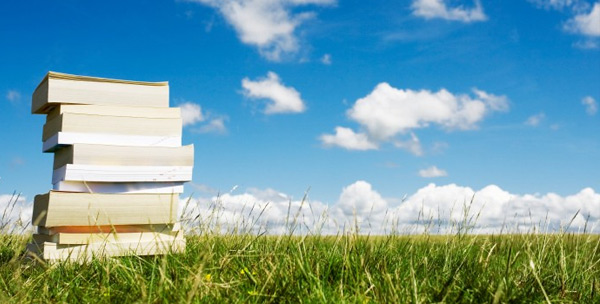

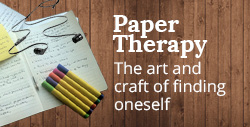
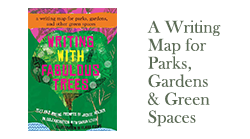

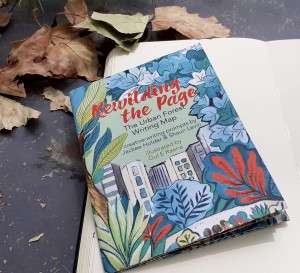

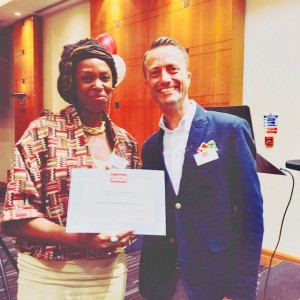
 d: Personal Best with life coach and author Jackee Holder explaining why we get caught up in habit and obligation at this time of year and how we can recapture the essence of what giving and receiving should be about.
d: Personal Best with life coach and author Jackee Holder explaining why we get caught up in habit and obligation at this time of year and how we can recapture the essence of what giving and receiving should be about. Given the work-generated negativity that I was disgorging into my book, I thought: well, why not? After she had left, I dropped my own bag on the grass and stepped into the labyrinth.
Given the work-generated negativity that I was disgorging into my book, I thought: well, why not? After she had left, I dropped my own bag on the grass and stepped into the labyrinth.

 It’s an illustrated collection of 12 Tree inspired writing prompts that explores the wisdom and lessons we can learn from trees as well as how tree wisdoms can provide insight and reflection on our own lives. In a handy pocket sized map that folds out the prompts also encourages a more intimate connection with the trees in your local neighbourhood, parks and green spaces through engagement with the writing prompts.
It’s an illustrated collection of 12 Tree inspired writing prompts that explores the wisdom and lessons we can learn from trees as well as how tree wisdoms can provide insight and reflection on our own lives. In a handy pocket sized map that folds out the prompts also encourages a more intimate connection with the trees in your local neighbourhood, parks and green spaces through engagement with the writing prompts.
 Trees have long inspired many poems, novels and short stories of writers in many ways. These creative writing prompts are devised to create a longer conversation about trees from your past and to stimulate you to indulge in a more reflective inquiry into how engaging and writing about trees can help you develop greater intimacy with yourself and your characters in sometimes surprising and unexpected ways. This writing map tucked into a pocket or a rucksack is the perfect companion on long walks in nature or whilst you are strolling through the city. You might be inspired to take a photo of a tree on your travels, slow down and experiment with drawing a tree to writing stories or personal narratives stimulated by the roots of your own family tree? The prompts and quotes generate learning and insight about yourself and where you come from as well as the opportunity to learn more about the host of benefits trees have to offer. Writing With Fabulous Trees will encourage you to be more observant about the trees in your neighbouring or surrounding parks and green spaces and even the trees in your street or in your own private garden will take on new and different meaning. Order Now £7.99 plus p&p
Trees have long inspired many poems, novels and short stories of writers in many ways. These creative writing prompts are devised to create a longer conversation about trees from your past and to stimulate you to indulge in a more reflective inquiry into how engaging and writing about trees can help you develop greater intimacy with yourself and your characters in sometimes surprising and unexpected ways. This writing map tucked into a pocket or a rucksack is the perfect companion on long walks in nature or whilst you are strolling through the city. You might be inspired to take a photo of a tree on your travels, slow down and experiment with drawing a tree to writing stories or personal narratives stimulated by the roots of your own family tree? The prompts and quotes generate learning and insight about yourself and where you come from as well as the opportunity to learn more about the host of benefits trees have to offer. Writing With Fabulous Trees will encourage you to be more observant about the trees in your neighbouring or surrounding parks and green spaces and even the trees in your street or in your own private garden will take on new and different meaning. Order Now £7.99 plus p&p









